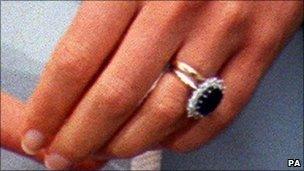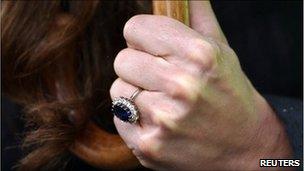Welsh gold wedding ring continues royal tradition
- Published

Princess Diana with her Welsh gold wedding ring, and engagement ring
When Prince William places a Welsh gold wedding ring onto Kate Middleton's finger, he'll be replicating an 88-year-old tradition dating back to the marriage of his great-grandparents, Elizabeth Bowes Lyon and the future George Vi.
In 1923, the royal ring was fashioned from a gift of Clogau gold with enough left over for the weddings of The Queen in 1947 as well as those of the late Princess Margaret, the Princess Royal and the 1981 marriage of Prince Charles and Diana.
The stock of the original Clogau gift is believed to be almost exhausted, having been replenished over the years with donations from several other Welsh mines.
Clarence House is remaining tight lipped over the precise source of the Welsh gold for Kate's wedding band.
In a statement to dispel speculation and confusing merchandising, the palace announced: "The wedding ring that Catherine Middleton will wear will be made of Welsh gold. The gold was given to Prince William by The Queen shortly after the couple were engaged."
"It has been in the family's possession for some years and has been in the care of the royal jewellers. There are no further details on which mine the gold was mined from."
Yet that hasn't stopped people jumping on the Welsh gold bandwagon; with four shopping channels listing Welsh gold sales for the royal wedding period, and airlines and duty-free shops stocking up for an anticipated holiday rush.
Although Ms Middleton's ring is made of Welsh gold, it's not clear from source it has been made, with at least three gifts to the royal family over the last century.
But just how similar to Kate's ring is the Welsh gold on offer to the public? And what's so special about Welsh gold anyway?
Dr Mike Bassett, expert in minerals and mining, said: "From its discovery by the Romans, up until when the colonial gold rushes of the 19th Century opened up new sources, the gold produced in Wales played a reasonable part in the British economy; though it was never regarded as anything distinct from gold in general."
"Welsh gold only became fashionable when the Queen Mother chose it for her wedding ring in 1923.
"But it's really an 'Emperor's new clothes' vanity, as it's visually and very nearly chemically indistinguishable; gold is gold is gold."
Same Welsh gold
Indeed, how royal and how Welsh the gold products currently being marketed are, is a tangled web of claim and counter-claim.
Last week, the Clogau gold company, which now owns the trading name and a quantity of gold from the defunct Clogau St David's mine, retracted a press release after an over-enthusiastic press officer claimed the company were to create Kate's wedding ring.
But whilst Clogau Gold moved quickly to scotch any confusion, they stand by what they say is their unique selling-point, that their rings are made from "the same Welsh gold as Kate's".
Dr Bassett says whilst this could well be the case, would-be Kate Middletons still ought to be careful, as the only way of proving it for definite could be costly.
"The royal stocks of Welsh gold have become so mixed up over the years, that I don't think even they themselves can have much degree of certainty over its precise origins any more," he said.
"If Kate, and the other brides would like to give up their wedding rings for melting down and isotopic analysis of the numbers of neutrons per atom, we'd be able to get to the bottom of whether they came from the same Clogau mine.

Kate Middleton will get a Welsh gold wedding ring too
"However I suspect that it's likely to remain a fascinating debate for the pub."
But the questions remains as to how to guarantee the Welshness of the gold.
The last working gold mine in north Wales, Gwynfynydd, closed in 1998; although extractions on anything close to a commercial basis ceased with the closure of Clogau near Dolgellau in 1911.
And with the world supply of Welsh gold ingots now believed to leave room to spare in an overnight bag, managing director of Clogau Gold Ben Roberts explains that they have to ration it to just "a touch" in each item of jewellery.
"We make no apologies about the small amount of Welsh gold that we put into each and every piece of our jewellery," he said.
"The precise amount is a common question but one that we try not to stipulate because it puts us on the hook to continue using the same percentage and it's one which might be subject to change in the future depending on supplies (although at present we have no plans to change the mix)."
Mr Roberts added: "We do however put a guarantee that all of our jewellery does contain our own gold and indeed we keep a very clear and concise audit trail to prove this."